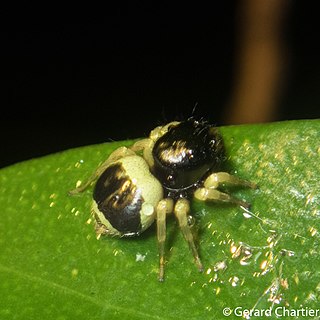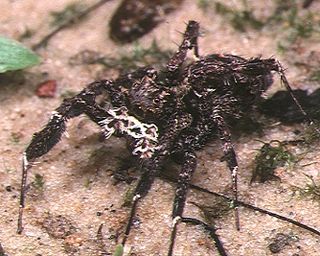
Myrmarachne is a genus of ant-mimicking jumping spiders that was first described by W. S. MacLeay in 1839. They are commonly called antmimicking spiders, but they are not the only spiders that have this attribute. The name is a combination of Ancient Greek μύρμηξ (myrmex), meaning "ant", and ἀράχνη (arachne), meaning "spider".

Anasaitis is a genus of jumping spiders that was first described by E. B. Bryant in 1950. The name is derived from the salticid genus Saitis.

Carrhotus is a genus of jumping spiders that was first described by Tamerlan Thorell in 1891. The name is derived from the Greek Κάῤῥωτος.
Colyttus is a genus of Asian jumping spiders that was first described by Tamerlan Thorell in 1891. It is named for the Latin word for "with two stripes". C. lehtinen is named in honor of Finnish arachnologist Pekka T. Lehtinen.
Euryattus is a genus of spiders in the family Salticidae.
Laufeia is a spider genus of the jumping spider family, Salticidae, with a mainly Asian distribution, where they are found on tree trunks and branches or among leaf litter.
Omoedus is a genus of jumping spiders.

Pancorius is a genus of Asian jumping spiders that was first described by Eugène Louis Simon in 1902. They are similar to Hyllus.
Pristobaeus is a genus of jumping spiders that was first described by Eugène Louis Simon in 1902.

Pystira is a genus of spiders in the jumping spider family Salticidae.

Rhene is a spider genus of the family Salticidae.
Sidusa is a genus of jumping spiders that was first described by George and Elizabeth Peckham in 1895.

Thiania is a genus of jumping spiders that was first described by Carl Ludwig Koch in 1846.

Thyene is a genus of jumping spiders that was first described by Eugène Louis Simon in 1885. It is a junior synonym of Mithion, and senior synonym of Paramodunda and Gangus.

Zenodorus is a genus of the jumping spiders distributed from the Moluccas to Australia, including several islands of the Pacific. It was once considered a junior synonym of Omoedus, but this was later rejected by Jerzy Prószyński in 2017. At least one species, Z. orbiculatus, specializes on hunting ants.

The Spartaeinae are a subfamily of the spider family Salticidae. The subfamily was established by Fred R. Wanless in 1984 to include the groups Boetheae, Cocaleae, Lineae, Codeteae and Cyrbeae, which in turn were defined by Eugène Simon.

The Plexippini are a tribe of jumping spiders (Salticidae). They have also been treated as the subfamily Plexippinae. They are native to the Old World.
Orcevia is a genus of Asian jumping spiders that was first described by Tamerlan Thorell in 1890. It was once considered a synonym of Laufeia, but it was revalidated in 2019.
Junxattus is a genus of spiders in the family Salticidae with a single described species, Junxattus daiqini, as of August 2020. It is native to Sumatra.











